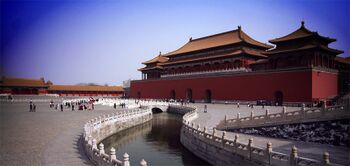Imperial Palace, Beijing
 From Citizendium - Reading time: 1 min
From Citizendium - Reading time: 1 min
The Imperial Palace in Beijing, China, dates to the Ming dynasty around 1406 to 1420 AD. The palace was home to 24 emperors between 1420 and 1911. It is listed as an UNESCO World Heritage site along the Imperial Palace in China's Shenyang city, under the name "Imperial Palaces of the Ming and Qing dynasties". During imperial China, foreigners and common people rarely could enter the palace and even then were restricted to the lesser buildings. Even state officials had to leave the palace at night, leaving only eunuchs, as servants, in the palace. This closed door policy earned the palace its pseudonyms as the Forbidden Palace or Forbidden City. It is known in Chinese as Gugong (故宫) which translates as 'Former Palace'. Today the one time Forbidden Palace is open to the public and one of China's foremost tourist attractions.
Covering an area of 720,000 square meters (just under 2.6 million square feet) and boasting 9,999 rooms, it can lay claim to being the largest palace complex in the world. The palace is surrounded by a 3,800 meter long and 52 meter wide moat.
 KSF
KSF